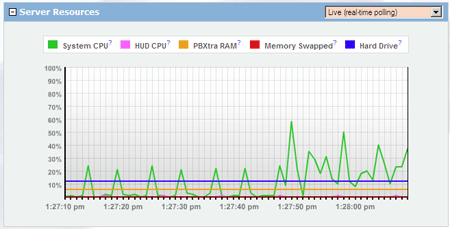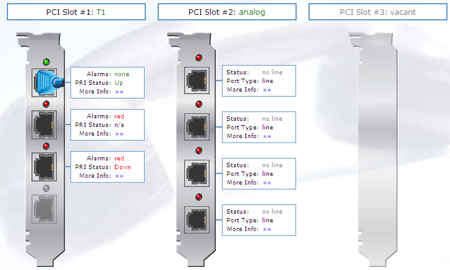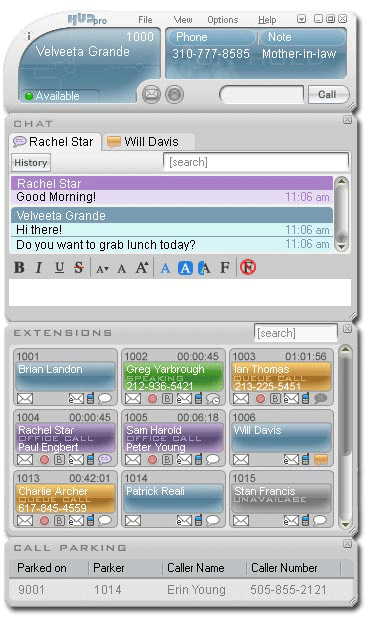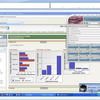If you think that statement is controversial, you should see the firestorm started by Voxilla's Marcelo Rodriguez in his inaccurate portrayal of Fonality as "unsecure" and open to an unscrupulous Fonality employee "spying" on their customer's networks. Marcelo even goes as far as to say customers are better of using Digium over Fonality when he says, "But those concerned about keeping company secrets are probably better served by Digium's offering. " I'm going to stay out of that battle, but it's worth checking out to see Chris Lyman's point-by-point rebuttal to Marcelo's assertions.
Getting back to today's news on their new PBXtra Professional Edition, Chris said, "On the PBXtra Pro side, this news brings is more scalability in terms of supporting more larger groups of extensions, faster - more concurrent calls - faster reporting - all the things that you need in a bigger office."
Tom: What did you do to make Asterisk more scalable?
Chris: What we've done on the web admin site is we re-engineered our entire back-end API to handle many more concurrent connections and easier management of multiple systems. We originally built that web interface to handle systems under 100 seats. So very difficult to manage as you got up into the hundreds of seats, it was hard to navigate, it was slow."
The newly re-engineered web interface lets you easily hotswitch from one branch office to another for configuring users, making adds/changes/etc.
Tom: You're using MySQL on the back-end, correct? Chris: Yes, we're using MySQL and so basically, we had to re-engineer the entire MySQL portion but just more intelligently to be a much faster system. We also cracked the hood on Asterisk and did a lot of work there to make our system 400% more scalable in terms of concurrent calls.
Tom: What are some of the bottlenecks in Asterisk that cause it to not scale so well?
Chris: The Asterisk management interface doesn't accept concurrent connections gracefully. So when you have an application such as HUD asking it a bunch of questions it starts to slow down and degrade the performance of the phone system. So we had to strengthen the hooks into Asterisk in order to support more concurrent activity.
Tom: How often are you polling from the HUD client to the the Asterisk server for presence and other info?
Chris: Multiple times per second and it broadcasts that info to every single subscribing HUD client. So think about it - you have 300 seats all asking questions and being broadcast. One person picks up the phone and has to tell 300 clients what happened. This all goes under the hood of scalability that we've worked on.
Chris went on to explain the new features with this release, including NPA/NPX call routing and unlimited party conference bridge. One really big feature is the new employee/extension grouping feature, which is exactly similar to PBX's COS (Class of Service) feature to determine permissions to do certain things on a "group" basis. For instance, you can define a department as having the ability to intercom page only within their own group and not other departments. On a related note, this latest release adds a 'group/zone intercom' feature, so with a few touch-tone presses (or mouse click within HUD) you can instantly page an entire group or zone. For instance, you can page your engineering group and ask, "Hey, what's everyone want for lunch". Since this is a VoIP system, it is location agnostic and you can instantly intercom conference employees in different locations, employees working from home for the day, etc.
Tom: What phones do you support for intercom paging, since not all VoIP phones support that feature?
Chris: We modified Polycom and Aastra phones to not only support intercom and paging, but to support cross-intercom and paging between Aastra and Polycom phones.
Chris also mentioned support for Cisco and Counterpath's softphone.
When I asked about QoS monitoring or statistics integrated onto the platform, I reminded Chris about a new feature that isn't in the official news release, namely a Web-based real-time reporting graph of various network statistics using SNMP polling of switches, as well as monitoring of the server's hard disk space, CPU utilization, PBXtra RAM usage, swapped memory, etc. Below is a screenshot of an area within my browser showing this feature:

You can also from the web interface graphically monitor the TDM (analog, T1/E1) hardware cards, as seen by this partial screenshot from my browser:

Amazingly, Fonality claims 1,300 customers and 18,000 users placing more than 40 million calls. More proof how Asterisk continues to be a major disruptive force in the IP-PBX/PBX industry!

HUD Team, Fonality's new universal contact management application (screenshot above), provides company-wide visibility and interaction with every employee from the desktop and includes secure enterprise chat, cell phone integration and employee presence management. They do an interesting application of presence - in addition to visually depicting the presence of employees within the HUD application, the server itself knows the status and you can set it up so incoming calls go directly to voicemail if your status is "away". The HUD Team software supports Windows and Mac desktops.
Tom: How much was it to upgrade existing customers?
Chris: We gave all existing customers a free upgrade to Professional Edition and we gave existing HUD customers a free upgrade to HUD Pro (HUD Team).
It bears repeating what Chris said - "The whole point of this launch is to start taking on the PBX giants. This isn't like 'Are we competitive in the Asterisk space?' We know that we're the leaders of that space, ok? This is about 'can we take on Avaya, Cisco, and Nortel - with feature-parity for 50/60/70% price reduction.' " It will be interesting to see if Chris's confidence in his product will be matched by actual sales. I for one am not betting against him!
PBXtra Professional Edition and HUD Team are available direct from Fonality or through a Fonality reseller. Pricing for PBXtra Professional Edition is $1,995 and HUD Team is $995 for unlimited seat licenses.













